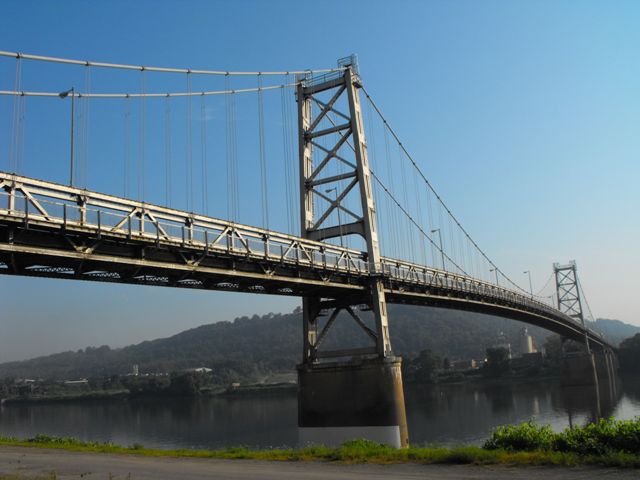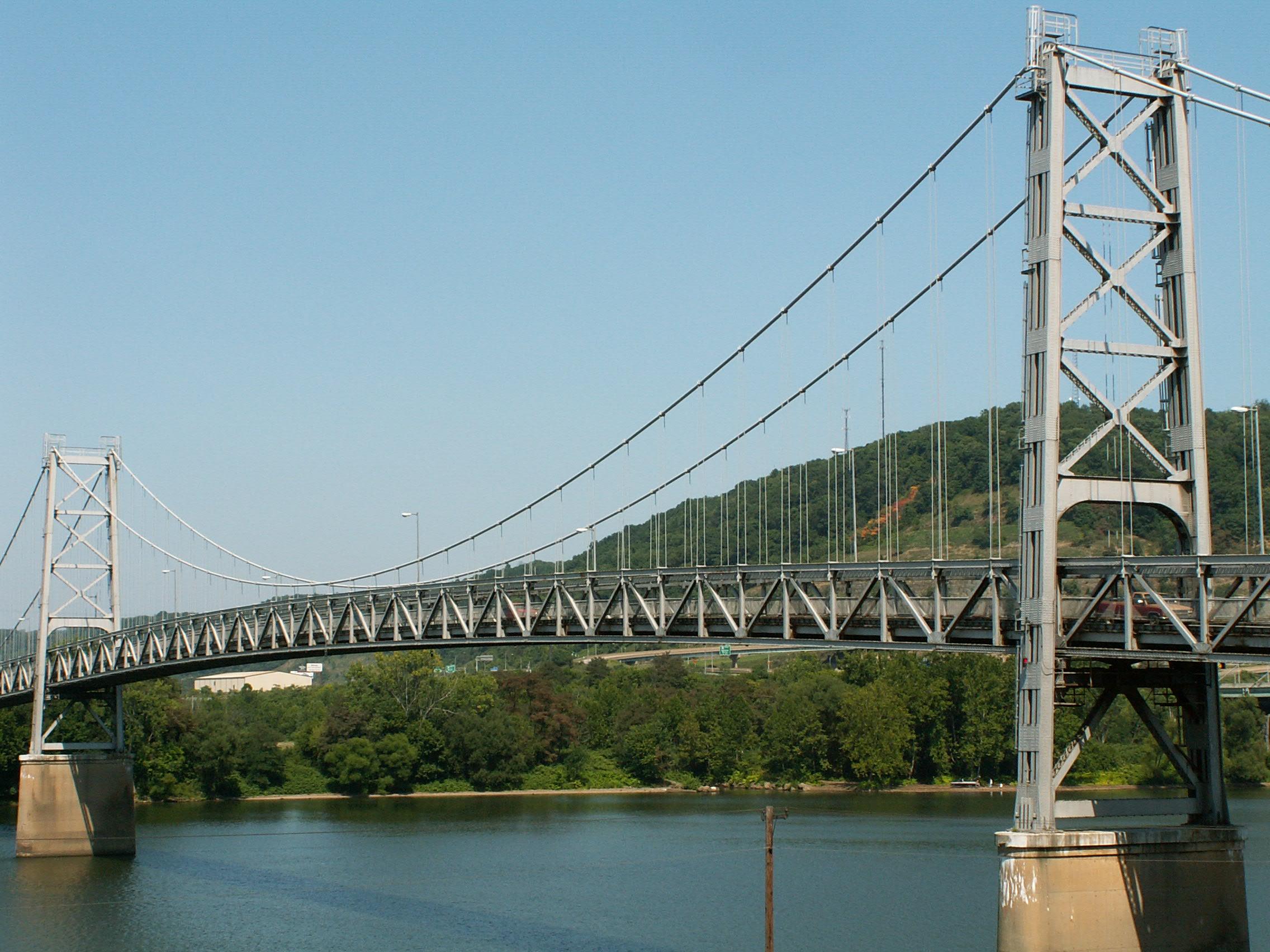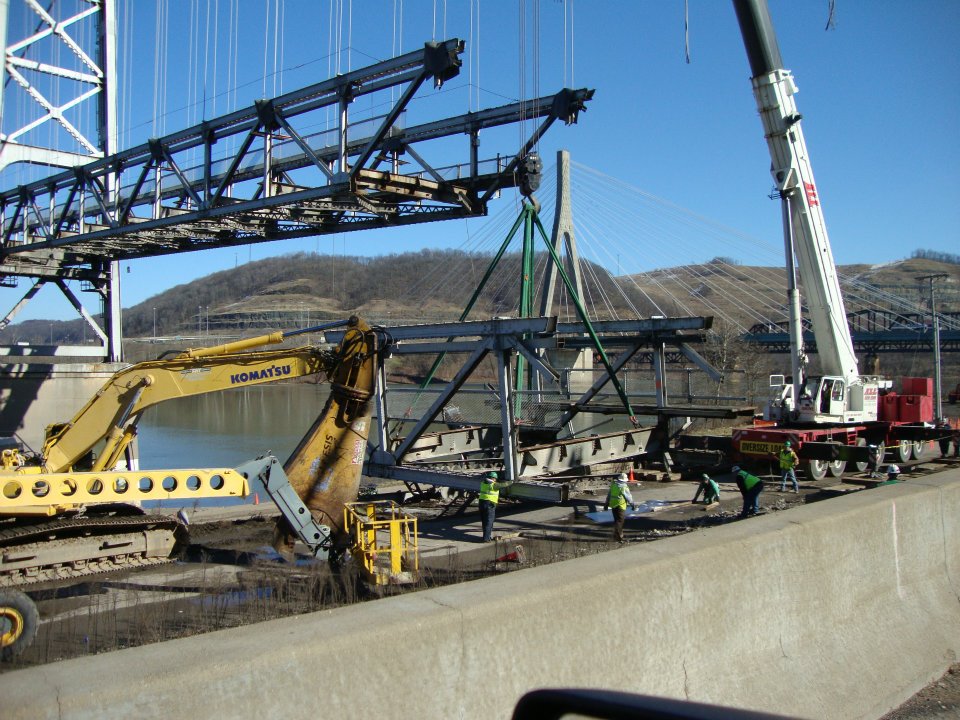We Recommend:
Bach Steel - Experts at historic truss bridge restoration.
Fort Steuben Bridge
Stanton Bridge
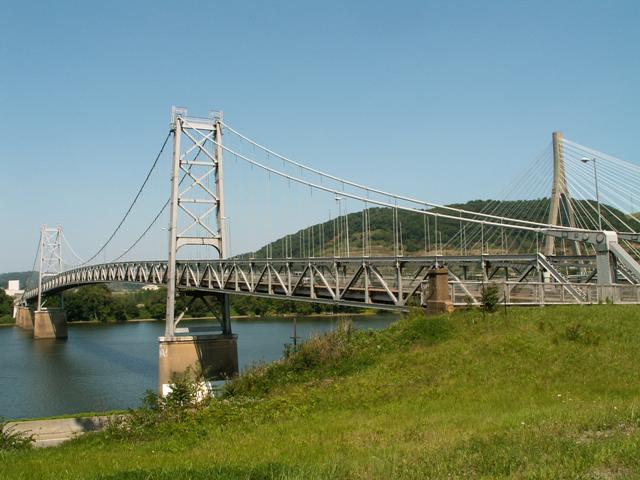
Primary Photographer(s): Nathan Holth and Rick McOmber
Bridge Documented: August 1, 2007
Steubenville and Weirton: Jefferson County, Ohio and Brooke County, West Virginia: United States
1928 By Builder/Contractor: Dravo Contracting Company of Pittsburgh, Pennsylvania and Engineer/Design: Clarence W. Hudson
1972
688.8 Feet (209.9 Meters)
1,585.0 Feet (483.1 Meters)
20.25 Feet (6.17 Meters)
3 Main Span(s)
4101987

View Information About HSR Ratings
Bridge Documentation
This bridge no longer exists!
This bridge's song is:
View Archived National Bridge Inventory Report - Has Additional Details and Evaluation
View Historical Article About This Bridge
View the Historic Bridge Inspection Report For This Bridge
View Original Structure Plans For This Historic Bridge (40mb PDF)
$2.3 Million Demolition of this historic bridge by Ohio Department of Transportation began in January 2012 with main span demolition occurring 7:15 AM EDT, February 21, 2012!
About This Bridge

This beautiful wonder of engineering is a classic 1920s wire-cable suspension bridge. The total suspended length is 1251.75 Feet (381.5 Meters), the center suspension span length is 688.75 Feet (210 Meters), and the approach suspension span length consists of two spans at 283 Feet (86.26 Meters) each. Navigational vertical underclearance is 86 Feet (26.2 Meters) and the vertical underclearance at the railroad line is 20.3 Feet (6.2 Meters).
The bridge features a lattice design for the tower structure. Speaking of which, lattice can also be found, along with v-lacing in some areas of on the bridge, although no members of the stiffening truss have either. The top chords of the trusses have v-lacing however, and the towers have lattice. The bottoms of the towers have an attractive arch to them. Both Carnegie and Jones and Laughlin brands can be found on the various steel parts of the bridge. Compared to the fairly nearby Market Street Bridge, the towers on this bridge feel very tall and impressive. Some of this is due to the fairly narrow roadway width, which gives the illusion that the towers are taller. The bridge retains good overall historic integrity for a bridge of this size, although i-beams have been added that run parallel to the top chord of the stiffening truss. Other modifications include replacement of connection rivets with bolts.
2012 Historic Bridge Demolition
"When ODOT's not out plowing snow or repairing the roads we also enjoy blowing up old bridges." -Quote from Ohio Department of Transportation describing the official video of the demolition.
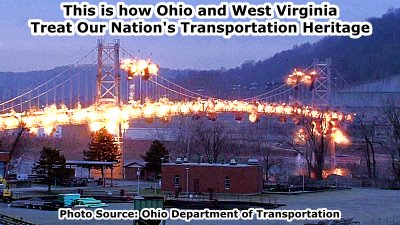
According to the above statement from the Department, the Ohio Department of Transportation takes pleasure in irreversibly destroying extremely rare historic bridges. Its hard to argue with their statement, given the number of historic bridges that Ohio has demolished in recent years. States like Ohio and Pennsylvania make the number of historic bridges destroyed in World War II in Europe seem modest. Indeed, ODOT and the hired demolition contractor carried out the complete destruction of this landmark far more efficiently and effectively than any wartime bomb could have, evidence of how much experience demolition contractors have the opportunity to gain, thanks to highway agencies like ODOT. When the Fort Steuben Bridge was built, engineers and contractors of the time could not have imagined how the demolition of a bridge like this could be brought down to a science that would destroy what they spent years designing and building in a matter of seconds. It is unfortunate that the Department might not instead take pleasure in preserving beautiful historic landmarks that would enhance the quality of life in Ohio.
Despite its obvious historic and aesthetic value, and potential for reuse as a non-motorized crossing, this historic bridge was demolished. The DOTs who owned this bridge said that every year the structure continued to deteriorate, and so the weight limit had to keep being lowered. Perhaps this was instead an indication that the DOTs are failing, not the bridge. Perhaps if the bridge had been properly maintained it would not be falling apart. Although it is the same age, Michigan and Ontario's Ambassador Bridge continues to serve traffic as the busiest North American international crossing with a major user being heavy fully-loaded semi trucks! Even at the time of demolition, the Fort Steuben Bridge could have and should have been restored. But instead, WVDOT and ODOT insisted on wasting $2.3 Million to demolish this bridge. Millions of valuable taxpayer dollars that could be used for anything from preserving this historic bridge to simply making area highways smoother and safer are instead being used to destroy this bridge just for the sake of wiping it off the face of the earth. They should instead focus funding into restoring this historic landmark and allowing it to continue to beatify Steubenville, Weirton, and the Ohio River. Such a graceful structure as a suspension bridge deserves to be left standing. Even people who are not generally "bridge enthusiasts" will often stop and photo a suspension bridge, because they are so large and impressive. To demolish a bridge such as this one is an atrocity to be sure. Both Ohio and West Virginia should be ashamed of themselves, not only for failing to maintain this bridge in the past, but also for not choosing to restore the bridge and make up for their past errors. Particular blame for this wasteful decision must be laid at ODOT's feet, since they acted as lead agency for the project. The demolition of the Fort Steuben Bridge is ridiculous.
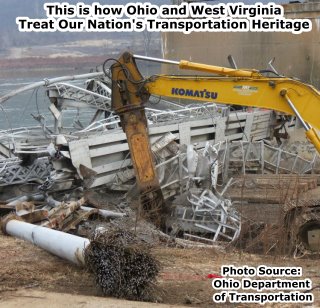
Think of all the material waste that demolition causes. The steel of the bridge, which could have been left in place, restored, and reused for a pedestrian crossing, are instead turned into scrap metal. This means that fuel and resources must be used to ship the steel to a scrap yard (possibly as far as China) where extensive energy must be expended to melt down and reuse the steel. Other materials on the bridge must also be shipped away and disposed of. Sure, historic bridge demolitions bring some jobs and profit to demolition contractors. But perhaps if more historic bridges were preserved, these contractors could retool their people and equipment to engage in the good work of preservation.
The $250,000 Lookout: Are You Kidding?!
One of the piers of the historic bridge was left standing. This pier will support a bridge structure that is to be constructed at the cost of a quarter million dollars to provide what is described as a lookout. Seriously?! The beautiful landmark has been destroyed! What is there left to look at? Additionally, why were the stiffening trusses of the historic bridge not saved and reused for this purpose? At least this would have saved a part of the historic bridge superstructure. A portion of the Rock Island Bridge in Minnesota was saved and reused in this manner. Instead, materials have been wasted and a new structure is to be used for this purpose. Even better, why could the entire bridge not have been the outlook? If the entire bridge had been left standing, both citizens of Weirton and Steubenville could have enjoyed the facility. Instead, officials opted for a solution that leaves the citizens of Weirton short-changed.
When The Smoke Clears...
The bridge may be gone, but HistoricBridges.org remains. HistoricBridges.org makes it a goal to encourage the preservation of historic bridges. When a historic bridge is demolished, HistoricBridges.org work continues by maintaining a page like this designed not only to document the appearance and design of the historic bridge, but to record the circumstances surrounding the demolition of the historic bridge.
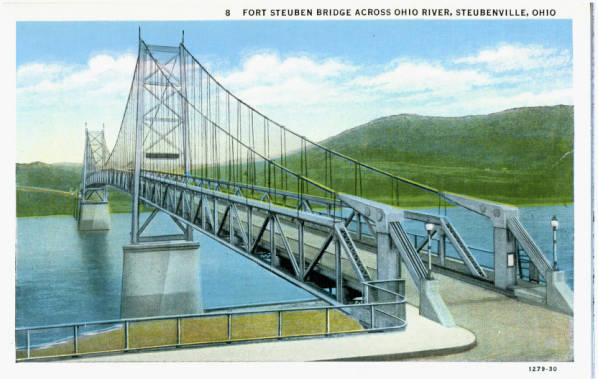
Above: Historical postcard of bridge.
![]()
Photo Galleries and Videos: Fort Steuben Bridge
2010 Photo-Documentation
Original / Full Size PhotosThe 2010 Documentation builds on previous documentation of the bridge by offering additional overview angles, particularly views from the south and east quadrants, as well as additional details of the West Virginia approach. This gallery offers photos in the highest available resolution and file size in a touch-friendly popup viewer.
Alternatively, Browse Without Using Viewer
![]()
2010 Photo-Documentation
Mobile Optimized PhotosThe 2010 Documentation builds on previous documentation of the bridge by offering additional overview angles, particularly views from the south and east quadrants, as well as additional details of the West Virginia approach. This gallery features data-friendly, fast-loading photos in a touch-friendly popup viewer.
Alternatively, Browse Without Using Viewer
![]()
2006-2009 Original / Full-Size Gallery
Original / Full Size Photos2006-2009 Documentations of the Fort Steuben Bridge. This original documentation of the Fort Steuben Bridge includes a comprehensive combination of overview and detail photos. Overview photos are primarilly from the north quadrant of the bridge. This gallery offers photos in the highest available resolution and file size in a touch-friendly popup viewer.
Alternatively, Browse Without Using Viewer
![]()
2006-2009 Structure Overview
Mobile Optimized PhotosA collection of overview photos that show the bridge as a whole and general areas of the bridge. 2006-2009 Documentations of the Fort Steuben Bridge. This original documentation of the Fort Steuben Bridge includes a comprehensive combination of overview and detail photos. Overview photos are primarilly from the west (Ohio) side of the bridge. This gallery features data-friendly, fast-loading photos in a touch-friendly popup viewer.
Alternatively, Browse Without Using Viewer
![]()
2006-2009 Structure Details
Mobile Optimized PhotosA collection of detail photos that document the parts, construction, and condition of the bridge. 2006-2009 Documentations of the Fort Steuben Bridge. This original documentation of the Fort Steuben Bridge includes a comprehensive combination of overview and detail photos. Overview photos are primarilly from the west (Ohio) side of the bridge. This gallery features data-friendly, fast-loading photos in a touch-friendly popup viewer.
Alternatively, Browse Without Using Viewer
![]()
Bridge Demolition
Mobile Optimized PhotosPhotos taken by Ohio Department of Transportation showing demolition of this historic bridge. This gallery features data-friendly, fast-loading photos in a touch-friendly popup viewer.
Alternatively, Browse Without Using Viewer
![]()
Bridge Demolition
Full Motion VideoOfficial demolition video, taken by Ohio Department of Transportation. WARNING: This video contains scenes of wanton and gratuitous violence toward historic bridges. Viewer discretion is advised. Historic bridges were harmed in the making of this video. Streaming video of the bridge. Also includes a higher quality downloadable video for greater clarity or offline viewing.
![]()
Maps and Links: Fort Steuben Bridge
This historic bridge has been demolished. This map is shown for reference purposes only.
Coordinates (Latitude, Longitude):
Search For Additional Bridge Listings:
Bridgehunter.com: View listed bridges within 0.5 miles (0.8 kilometers) of this bridge.
Bridgehunter.com: View listed bridges within 10 miles (16 kilometers) of this bridge.
Additional Maps:
Google Streetview (If Available)
GeoHack (Additional Links and Coordinates)
Apple Maps (Via DuckDuckGo Search)
Apple Maps (Apple devices only)
Android: Open Location In Your Map or GPS App
Flickr Gallery (Find Nearby Photos)
Wikimedia Commons (Find Nearby Photos)
Directions Via Sygic For Android
Directions Via Sygic For iOS and Android Dolphin Browser
USGS National Map (United States Only)
Historical USGS Topo Maps (United States Only)
Historic Aerials (United States Only)
CalTopo Maps (United States Only)







